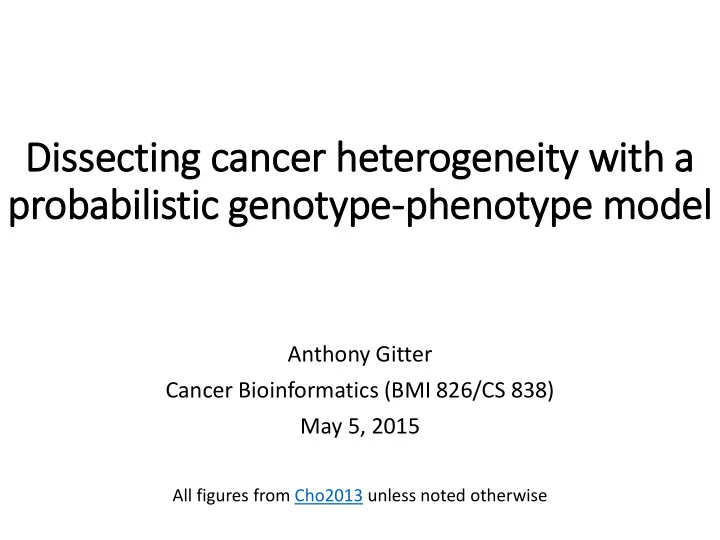

Dissecting cancer heterogeneity with a probabilistic genotype-phenotype model Anthony Gitter Cancer Bioinformatics (BMI 826/CS 838) May 5, 2015 All figures from Cho2013 unless noted otherwise
Class business • Project presentations Thursday • Guidelines on website • Project report due May 11 • How to schedule presentation order?
Inspiration from CMapBatch Chris rank 1 Jiayue rank 4 Network stratification project rank √4 (1) Anita rank 7 Vee rank 6 Survival prediction project rank √42 (3) Taylor rank 3 Haixiang rank 5 Erkin rank 2 Outlier Clustering pipeline project rank √15 (2)
Subtyping in cancer • Substantial differences across tumors even within one type of cancer • Molecular alterations • Survival outcomes • Response to therapy
Traditional subtyping • Learn gene expression signature to distinguish classes • AML vs ALL • PAM50 for breast cancer • Glioblastoma (GBM) Verhaak2010
GBM subtypes • Learn class centroids with ClaNC (classification to nearest centroids) • t-test statistic to identify genes • 210 genes per class in GBM • Neural subtype has been criticized Verhaak2010
Many analyses depend on subtypes • MutSig or other enrichment tests
Many analyses depend on subtypes • Group lasso in regulator regression Setty2012
Many analyses depend on subtypes • DIGGIT functional CNV association test Chen2014
Problem with subtype classifiers • Cancer and individual tumors are heterogeneous Ding2014
Heterogeneity in expression classification • Single-cell RNA-seq shows a single GBM tumor is composed of cells from multiple subtypes Patel2014
Prob_GBM: mixtures of subtypes • Patients are mixtures of subtypes • Subtypes are mixtures of genomic factors • Sound familiar?
Relation to Non-negative Matrix Factorization • Network-based stratification • Similar concepts, different strategies Hoffree2013
Prob_GBM model • Gene expression is a molecular level phenotype • Treated as effect of disease, not cause • Patient-patient similarity based on expression • Genomic factors cause disease • Mutations, CNV, miRNAs • Expression similarities explained by genomic similarities
Build patient-patient similarity network
Choose co-expression threshold
Learn subtype distributions
Likelihood of edge between similar patients from subtype assignments
Inspired by relational topic model • Documents are bags of words • Document-document citation network Chang2010
Mapping to cancer domain • Documents = patients • Bag of words = bag of genomic alterations • Document citation link = patient-patient co- expression above some threshold
Generative probabilistic model d -> p patient w -> g subtype “gene” “gene” patients Chang2010
Generative probabilistic model Chang2010 γ
Prob_GBM distributions • Joint distribution • Posterior distribution of the latent variables
Model estimation • Cannot maximize posterior exactly • Gibbs sampling generates samples from this distribution • Two Gibbs sampling references: • 1 page summary • 231 slide tutorial
Latent variables of interest Subtype Distributions of distributions per genomic patient p alteration n under subtype k
Visualizing patient distributions
Visualizing genomic alteration distributions
Assigning patients to subtypes
Neural is mixture of subtypes
Stability of subtype assignments
Ultimate patient-subtype, alteration-subtype associations
Recommend
More recommend